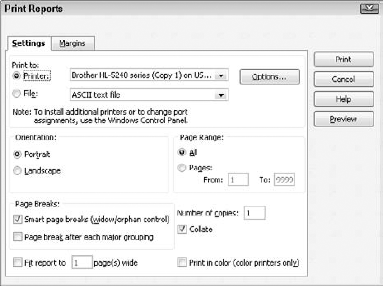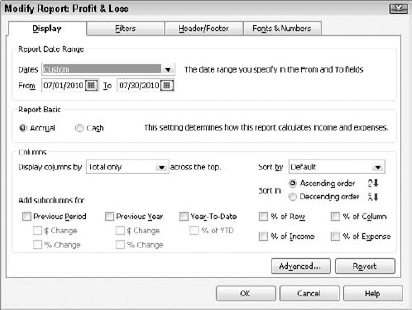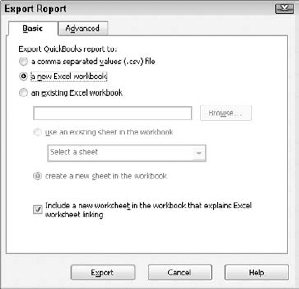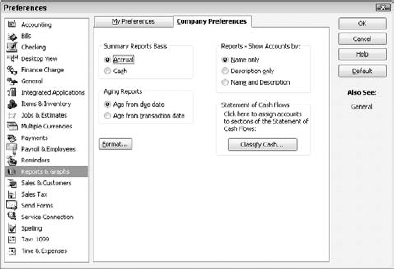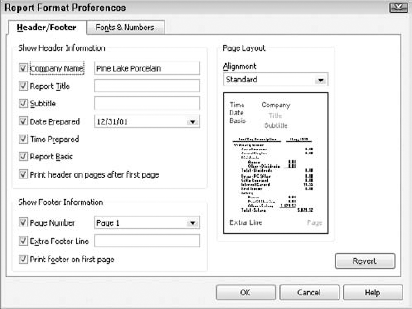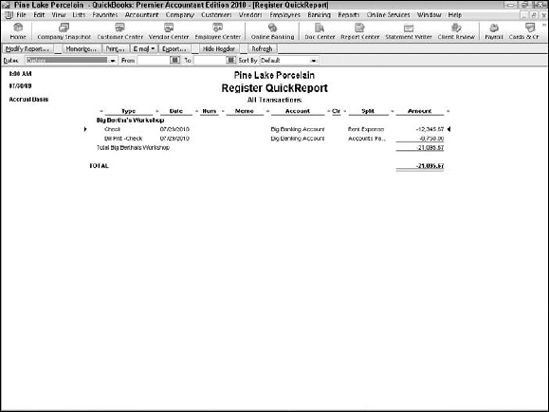In This Chapter
Printing QuickBooks reports
Using the Reports menu commands
QuickZooming report totals
Sharing information with a spreadsheet
Editing and rearranging report information
Processing multiple reports
Using QuickReports
To find out whether your business is thriving or diving, you use the QuickBooks Reports feature. The different kinds of reports in QuickBooks cover everything from cash flow to missing checks, not to mention QuickReports. QuickReports are summary reports that you can get from the information on forms, account registers, or lists by merely clicking the mouse.
In this chapter, I tell you how to prepare reports, how to print them, and how to customize reports for your special needs.
If you run a small business, you don't need all the reports that QuickBooks offers, but many of these reports are extremely useful. Reports show you how healthy or unhealthy your business is, where your profits are, and where you're wasting time and squandering resources.
Table 15.1. QuickBooks Report Categories
Report Category | Description |
|---|---|
Company & Financial | These reports give you a bird's-eye view of your company's health and cash flow. They give you a snapshot of your assets, liabilities, and equity, showing income, expenses, and net profit or loss over time. |
Customers & Receivables | These accounts receivable reports are great for finding out where you stand in regard to your customer invoices. You can list unpaid invoices and group them in various ways, including by customer, job, and aging status. |
Sales | These reports show what you sold and who your customers are. You can see your sales by item, by customer, or by sales representative. |
Jobs, Time & Mileage | These reports let you see job and item profitability, compare job estimates versus actual costs, view time recorded on jobs and activities, and look at vehicle mileage. |
Vendors & Payables | These accounts payable reports tell you everything you need to know about your unpaid bills. You can list bills in a variety of ways, including by vendor and by aging status. This category also includes a report for determining sales tax liability. |
Purchases | These reports show from whom you bought, what you bought, and how much you paid. You can list purchases by item or by vendor. One handy report shows any outstanding purchase orders. |
Inventory | These reports help answer the ever-important question, "What items do I have in stock?" You can get an enormous amount of detail from these reports. For example, you can find out how many of an item you have on hand and how many you have on order. You can group inventory by vendor or by item. If you need price lists, you can print them by using a special report from your QuickBooks file. |
Employees & Payroll | These reports, available if you've signed up for one of the QuickBooks payroll options, offer ways to track payroll or check your payroll liability accounts. Believe me: These reports come in handy. |
Banking | These reports list checks and deposits. |
Accountant & Taxes | These reports include income tax reports, journal and general ledger reports, and a trial balance. |
Budgets & Forecasts | These reports show you once and for all whether your budgeting skills are realistic. You can view budgets by job, by month, or by balance sheet account. Then you can compare the budgets with actual income and expense totals. (You need to have a budget already set up to use this report — something I discuss in Chapter 12.) |
List | These reports let you see your lists in detail. For example, you can see the contacts, phone numbers, and addresses on your Customer, Vendor, or Other Names lists. You also can create a detailed report of your inventory. |
Industry Specific | Some versions of QuickBooks also supply industry-specific reports under the Industry Specific submenu command. QuickBooks, at the time of this writing, provides industry-specific versions of QuickBooks for accountants, contractors, manufacturers, wholesalers, professional service firms, retailers, and nonprofit organizations. |
To make sense of what might otherwise become mass confusion, QuickBooks organizes all its reports in categories. You can see what all the categories are by pulling down the Reports menu or by clicking the Report Center icon. The names of the reports read a bit like public television documentary names, don't they? "Tonight, Joob Taylor explores the mazelike federal budget in Budget Reports." You select a report category to see a list of report names.
In Table 15-1, I describe reports by category and give a short description of the major reports in each category. To get a thorough description of a particular report, go to the Help feature. To find out what a standard profit and loss report does, for example, choose Help
Tip
If you're not sure which specific report you want, you can use the Report Center. Just choose Reports
After you decide what report you need, all you have to do is select it from the appropriate menu. To create a standard profit and loss report, for example, choose Reports
Depending on how much data QuickBooks has to process, you may see a Building Report box before the report appears onscreen in all its glory. Figure 15-2 shows a standard profit and loss report, also called an income statement.
Tip
If you see a Customize Report dialog box instead of a report, you can tell QuickBooks to change this option. To do so, choose Edit
Note
You can't see the entire onscreen version of a report unless your report is very small (or your screen is monstrously large). Use the Page Up and Page Down keys on your keyboard to scroll up and down, and use the Tab and Shift+Tab keys to move left and right. Or, if you're a mouse lover, you can use the scroll bar.
To print a report, click the Print button at the top of the report. QuickBooks displays the Print Reports dialog box, as shown in Figure 15-3. To accept the given specifications, which are almost always fine, click the Print button. You'll never guess what happens next: QuickBooks prints the report!
The first time you print a report, QuickBooks displays a Printing Features dialog box that explains a few things about the mechanics of choosing and printing reports.
Note
Before I forget, I want to tell you that you can select the File radio button in the Print To panel to tell QuickBooks to save the report as a file instead of printing it. You can then choose the file format: ASCII Text File, Comma Delimited File, or Tab Delimited File. You can use either delimited-file format if you want to open the file later with a spreadsheet program, such as Microsoft Excel. After you click Print, use the Create Disk File dialog box to specify the filename and storage location.
Another really popular option is to "print" your report to your desktop as a PDF file that can be attached to an e-mail and sent to anyone you choose. After sending, you can drag the file to your Recycle Bin. Anything that you can print can be processed this way and e-mailed. Some documents in QuickBooks, such as Invoices, have an icon that supports PDF e-mailing; these documents are processed online through the Intuit servers. If you "print" them to the desktop and send them manually, you use your own e-mail server and send them as attachments. You need to have a PDF printer driver installed on your computer to use this function. These can be downloaded online for free if you don't have one already, such as from www.primopdf.com.
The Orientation settings tell QuickBooks how the report is supposed to appear on the paper. The Page Range settings specify the pages that you want to print. The Fit Report to xx Page(s) Wide check box enables you to shrink the report so that it fits on the number of pages you specify. The purpose of the Print in Color (Color Printers Only) check box is pretty self-evident.
QuickBooks includes two page-break options for creating easier-to-read reports:
Select the first check box (smart page breaks) to keep items that belong in the same group on the same page.
Select the second check box to give each major group its own page.
You also can preview the report by clicking the Preview button.
You can do some neat things with the reports you create. Here's a quick rundown of some of the most valuable tricks:
QuickZooming mysterious figures: If you don't understand where a number in a report comes from, point to it with the mouse. As you point to numbers, QuickBooks changes the mouse pointer to a magnifying glass marked with a Z. Double-click the mouse to have QuickBooks display a list of all the transactions that make up that number.
This feature, called QuickZoom, is extremely handy for understanding the figures that appear on reports. All you have to do is double-click any mysterious-looking figure in a report. QuickBooks immediately tells you exactly how it arrived at that figure.
Sharing report data with Microsoft Excel: You can export report data to an Excel spreadsheet by clicking the Export button in the report window. QuickBooks displays the Export Report to Excel dialog box. You can use this dialog box to specify whether you want to create a new spreadsheet for the report data or whether you want to add the report data to an existing spreadsheet.
You may have noticed that when QuickBooks displays the report document window, it also displays a row of buttons: Modify Report, Memorize, Print, E-Mail, Export, and so on (as you can see in Figure 15-2, if you look carefully). Below this toolbar are some drop-down lists that have to do with dates, a drop-down list called Columns, and a drop-down list called Sort By. (Not all these list boxes are available in every report document window. I don't know why, really. Maybe just to keep you guessing.)
You don't need to worry about these buttons and lists. Read through the discussion that follows only if you're feeling comfortable, relaxed, and truly mellow, okay?
When you click the Modify Report button, QuickBooks displays the Modify Report dialog box, as shown in Figure 15-4. From this dialog box, you can change the information displayed on a report and the way that information is arranged (by using the Display tab); the data used to generate the report (by using the Filters tab); the header and footer information (by using, predictably, the Header/Footer tab); and the typeface and size of print used for a report (by using the Fonts & Numbers tab).
If you do play around with the remaining buttons, you can save any custom report specifications that you create. Just click the Memorize button. QuickBooks displays the Memorize Report dialog box (as shown in Figure 15-5), which asks you to supply a name for the customized report and assign the memorized report to a report group. After you name and assign the customized report, QuickBooks lists it whenever you choose Reports
Tip
QuickBooks memorizes the print orientation with the report, so if the print orientation isn't the way you want it for the report, you should first change it by choosing File
If you click the E-Mail button, QuickBooks displays a drop-down list of commands that lets you e-mail either an Excel workbook or a PDF version of the report to someone else. When you choose the command that corresponds to the report file format you want to e-mail, QuickBooks displays the Edit E-Mail Information box. All you need to supply is the receiving person's e-mail address.
If you click the Export button, QuickBooks displays the Export Report dialog box (see Figure 15-6). You can use this dialog box to create an Excel report that holds the same information as shown in the report. (To do this, just press Enter when you see the Export Report dialog box.) You can also get fancier in your exporting by exporting a comma-separated values file (these files can be opened by other electronic spreadsheet programs and by database programs), by exporting to a specific Excel workbook file, and by using the Advanced tab to control how the exported information is formatted.
A friendly suggestion, perhaps? Feel free to experiment with all the special exporting options. Just remember that after you export a QuickBooks report to a new, blank Excel workbook, you can also do any of this fancy-dancey stuff — special formatting and so on — there.
If you intend to print a large number of reports — and, more important, if you intend to print a large number of reports and show them to customers, investors, and other significant people — you want your reports to look good and to be easy to understand. I believe that beauty is in the eye of the beholder, so I'm not going to get into the aesthetics of report layouts. What I am going to do is explain how you can make QuickBooks reports look exactly the way you want them to look.
Choose Edit
Note
You need to be logged in to single-user mode as the administrator to change company preferences. Read how in Appendix C.
Here are your options:
Accrual: Accrual is one of those cruel accounting terms that are hard to understand at first. If you select the Accrual radio button in the Summary Reports Basis panel, you tell QuickBooks to include all your transactions, sales, purchases, expenses, and so on, from the moment they're recorded, not from the time you receive or pay cash for them.
Accountants follow the accrual method because it gives a more accurate picture of profits. Also, the Internal Revenue Service (IRS) says that big corporations must use accrual accounting for their tax returns.
Cash: If you select the Cash radio button, all the financial transactions in your reports are counted at the time you make your expense payments and you receive your customers' payments.
Age from Due Date: If you select the Age from Due Date radio button in the Aging Reports panel, QuickBooks counts your expenses and invoices from the day that they fall due. Otherwise, QuickBooks counts them from the day they're recorded.
Format: Click the Format button if you want to improve the look of your reports. In the Report Format Preferences dialog box that appears, as shown in Figure 15-8, you can use the Header/Footer tab to choose preferences for displaying the company name, the report title, the subtitle, and so on.
Reports – Show Account By: You select a radio button in the Reports Show By button group to indicate how you want QuickBooks to arrange account information on your reports: by name, by description, or by both name and description.
Statement of Cash Flows: You click the Classify Cash button to tell QuickBooks how it should handle its accounts when it produces a picture-perfect statement of cash flows using generally accepted accounting principles. A suggestion? Leave this for your CPA.
Tip
You can use the Fonts & Numbers tab to choose preferences for displaying numbers, decimal fractions, and negative numbers. You also can fool around with different fonts and point sizes for labels, column headings, titles, and other things in your reports.
Tip
Click the Revert button in the Report Format Preferences dialog box to undo your customization changes.
Want to print several reports at once? No problem. Choose Reports
The QuickReport is one of the best kinds of reports, so I saved it for last. You can generate a QuickReport from a list, from invoices and bills with names of people or items on them, and from account registers. QuickReports are especially useful when you're studying a list and see something that momentarily baffles you. Simply make sure that the item you're curious about is highlighted, click the Reports button, and choose the QuickReports command for the item from the drop-down list.
Note
You can also right-click an item and choose QuickReport from the shortcut menu to create a QuickReport of the item.
Figure 15-10 shows a QuickReport produced from a Checking register. I clicked the QuickReport button to display this Register QuickReport window with the transaction information for a vendor: the fictitious Big Bertha's Workshop.



